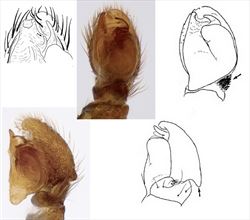
Aspects of the general morphology of Pseudosynagelides
Illustrators (and ©) B.J. Richardson (CSIRO), M. Zabka (diag.) (QMB)

Palp morphology of Pseudosynagelides
Illustrators (and ©) B.J. Richardson (CSIRO), M. Zabka (diag.) (QMB)

Epigyne morphology of Pseudosnagelides
Illustrators (and ©) B.J. Richardson (CSIRO), M. Zabka (diag.) (QMB)
Pseudosynagelides Zabka, 1991
Taxonomy
Pseudosynagelides has six Australian species; Pseudosynagelides australensis, P. bunya, P. elae, P. monteithi, P. raveni and P. yorkensis. Further information on the genus and described species in Australia can be found in Richardson and Żabka (2017). Its taxonomic relationships to other genera are unknown (Maddison, 2015).
Description
Pseudosynagelides spp. are small spiders, body lengths less than 3 mm. The head, viewed from above, is squared off at the front with straight sides tapering to the rear and widest at the anterior lateral eyes in the female, narrower and pear-shaped in the males. The cephalothorax is low, with a flattened upper surface presenting a frosted appearance. The abdomen is ovate in males and heart-shaped in females. Chelicerae have a single (unident) retromarginal tooth and one or two promarginal teeth. The fourth pair of legs is longest. While the first pair is not much stronger than the others they are armed with two pairs of strong spines on each metatarsus. Any other spines on all legs are tiny or absent.
The male palp has a short, blunt embolus arising on the prolateral side edge of the tegulum. The embolus is either single or accompanied by an associated sclerite, depending on the species. The tegulum is round with a small proximal lobe and a large distal apophysis. The cymbium also has retro-lateral and dorso-lateral apophyses. The tibia of the palp has one or two short apophyses; the shape and number varying between species. There is also a distinct bump on the femur of the palp combined with a fixed connection between the femur and the patella.
The female has two small, poorly-sclerotised epigynal atria with median copulatory openings in pockets. The insemination ducts follow a winding course posteriorly to rounded or pear-shaped spermathecae close to the epigastric fold.
Biology
Found in litter in open forests, melaleuca wetlands and rainforest.
Distribution
The genus occurs widely across eastern Australia from northern Queensland to Tasmania in higher rainfall areas.
References
Maddison, W.P. (2015). A phylogenetic classification of jumping spiders (Araneae: Salticidae). Journal of Arachnology 43, 231-292.
Richardson, B.J. & Żabka, M. 2017. Salticidae. Arachnida: Araneomorphae. Canberra, Australian Faunal Directory. Australian Biological Resources Study, at https://biodiversity.org.au/afd/taxa/SALTICIDAE.
Żabka, M. 1991. Salticidae (Arachnida: Araneae) of Oriental, Australian and Pacific Regions, VII. Mopsolodes, Abracacdabrella and Pseudosynagelides — new genera from Australia. Memoirs of the Queensland Museum 30, 621-644.
Whyte, R. and Anderson, G. 2017. A field guide to the spiders of Australia. Clayton: CSIRO Publishing 451pp.
* The information sheet should be read in the context of the associated diagrams and photographs. Diagrams explaining anatomical terms can be found in the ‘Salticidae’ pictures at the beginning of the list of genera.